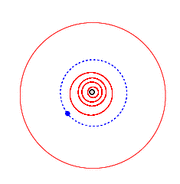9921 Rubincam
9921 Rubincam, provisional designation 1981 EO18, is a stony asteroid from the inner regions of the asteroid belt, approximately 4 kilometers in diameter. It was discovered on 2 March 1981, by American astronomer Schelte Bus at the Siding Spring Observatory in Australia, and later named after American geophysicist David Rubincam.[2]
 Orbit of Rubincam (blue), inner planets and Jupiter (outermost) | |
| Discovery [1] | |
|---|---|
| Discovered by | S. J. Bus |
| Discovery site | Siding Spring Obs. |
| Discovery date | 2 March 1981 |
| Designations | |
| (9921) Rubincam | |
Named after | David Rubincam (American geophysicist)[2] |
| 1981 EO18 | |
| main-belt · (inner) [3] | |
| Orbital characteristics [1] | |
| Epoch 4 September 2017 (JD 2458000.5) | |
| Uncertainty parameter 0 | |
| Observation arc | 63.45 yr (23,175 days) |
| Aphelion | 2.5174 AU |
| Perihelion | 2.2352 AU |
| 2.3763 AU | |
| Eccentricity | 0.0594 |
| 3.66 yr (1,338 days) | |
| 91.234° | |
| 0° 16m 8.76s / day | |
| Inclination | 2.4008° |
| 331.39° | |
| 89.205° | |
| Physical characteristics | |
| Dimensions | 4.10 km (calculated)[3] 4.250±0.094 km[4][5] |
| 8.01±0.03 h[6] 8.014±0.0017 h[7] | |
| 0.20 (assumed)[3] 0.204±0.035[4][5] | |
| S [3] | |
| 14.2[4] · 14.276±0.001 (R)[7] · 14.3[1][3] | |
Orbit and classification
Rubincam is a stony S-type asteroid that orbits the Sun in the inner main-belt at a distance of 2.2–2.5 AU once every 3 years and 8 months (1,338 days). Its orbit has an eccentricity of 0.06 and an inclination of 2° with respect to the ecliptic.[1] A first precovery was taken at Palomar Observatory in 1953, extending the body's observation arc by 28 years prior to its official discovery at Siding Spring.[2]
Physical characteristics
Lightcurves
In February 2010, two rotational lightcurves of Rubincam were obtained from photometric observations at the Palomar Transient Factory in California. Lightcurve analysis gave a rotation period of 8.01 and 8.014 hours with a brightness amplitude of 0.33 and 0.31 in magnitude, respectively (U=3-/2).[6][7]
Diameter and albedo
According to the survey carried out by NASA's Wide-field Infrared Survey Explorer with its subsequent NEOWISE mission, Rubincam measures 4.250 kilometers in diameter and its surface has an albedo of 0.204,[4][5] while the Collaborative Asteroid Lightcurve Link assumes a standard albedo for stony asteroids of 0.20 and calculates a diameter of 4.1 kilometers with an absolute magnitude of 14.3.[3]
Naming
This minor planet was named after David Rubincam (born 1947), an American solid-earth geophysicist and planetary geodynamicist at NASA's Goddard Space Flight Center in Greenbelt, Maryland. He was the first to study the influence of the radiation recoil effects on an asteroid's rotation period and spin axis, which he later named the Yarkovsky–O'Keefe–Radzievskii–Paddack effect or YORP effect for short.[2] The official naming citation was published by the Minor Planet Center on 28 September 2015 (M.P.C. 95803).[8]
References
- "JPL Small-Body Database Browser: 9921 Rubincam (1981 EO18)" (2017-03-14 last obs.). Jet Propulsion Laboratory. Retrieved 22 June 2017.
- "9921 Rubincam (1981 EO18)". Minor Planet Center. Retrieved 10 April 2017.
- "LCDB Data for (9921) Rubincam". Asteroid Lightcurve Database (LCDB). Retrieved 10 April 2017.
- Mainzer, A.; Grav, T.; Masiero, J.; Hand, E.; Bauer, J.; Tholen, D.; et al. (November 2011). "NEOWISE Studies of Spectrophotometrically Classified Asteroids: Preliminary Results". The Astrophysical Journal. 741 (2): 25. arXiv:1109.6407. Bibcode:2011ApJ...741...90M. doi:10.1088/0004-637X/741/2/90.
- Masiero, Joseph R.; Mainzer, A. K.; Grav, T.; Bauer, J. M.; Cutri, R. M.; Dailey, J.; et al. (November 2011). "Main Belt Asteroids with WISE/NEOWISE. I. Preliminary Albedos and Diameters". The Astrophysical Journal. 741 (2): 20. arXiv:1109.4096. Bibcode:2011ApJ...741...68M. doi:10.1088/0004-637X/741/2/68.
- Polishook, D.; Ofek, E. O.; Waszczak, A.; Kulkarni, S. R.; Gal-Yam, A.; Aharonson, O.; et al. (April 2012). "Asteroid rotation periods from the Palomar Transient Factory survey". Monthly Notices of the Royal Astronomical Society. 421 (3): 2094–2108. arXiv:1201.1930. Bibcode:2012MNRAS.421.2094P. doi:10.1111/j.1365-2966.2012.20462.x.
- Waszczak, Adam; Chang, Chan-Kao; Ofek, Eran O.; Laher, Russ; Masci, Frank; Levitan, David; et al. (September 2015). "Asteroid Light Curves from the Palomar Transient Factory Survey: Rotation Periods and Phase Functions from Sparse Photometry". The Astronomical Journal. 150 (3): 35. arXiv:1504.04041. Bibcode:2015AJ....150...75W. doi:10.1088/0004-6256/150/3/75.
- "MPC/MPO/MPS Archive". Minor Planet Center. Retrieved 10 April 2017.
External links
- Asteroid Lightcurve Database (LCDB), query form (info)
- Dictionary of Minor Planet Names, Google books
- Asteroids and comets rotation curves, CdR – Observatoire de Genève, Raoul Behrend
- Discovery Circumstances: Numbered Minor Planets (5001)-(10000) – Minor Planet Center
- 9921 Rubincam at AstDyS-2, Asteroids—Dynamic Site
- 9921 Rubincam at the JPL Small-Body Database
